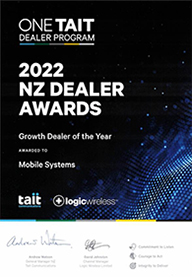Blogs
Transport Company Expands Push-To-Talk over LTE
To support their growing business, a New Zealand transport company needed a communications solution that would give them greater coverage than their existing analog radio network. To leverage existing equipment and minimize user training, Hilton Haulage chose to extend their radio communications over the cellular network with Tait Unified Vehicle.
The Client: Hilton Haulage
Hilton Haulage is one of New Zealand’s leading suppliers of transport and storage facilities, based in the wider Canterbury region and servicing areas across New Zealand. With over 450 staff and more than 200 vehicles in their fleet, communication on the road is essential for organizing day-to-day business and ensuring staff health and safety.
Situation: The Need for Greater Coverage
Hilton Haulage has a largely mobile workforce across a large geographic area that includes remote rural locations. The company uses a transport job management solution to keep track of tasks and has visibility of truck location through an existing GPS solution.
 Their existing communication system was an open channel, wide area analog linked radio network. Whilst this existing solution was reliable and served the needs of their business initially, the cost to extend this network to cover Hilton’s ever-growing service area was proving to be too costly, so alternatives had to be considered.
Their existing communication system was an open channel, wide area analog linked radio network. Whilst this existing solution was reliable and served the needs of their business initially, the cost to extend this network to cover Hilton’s ever-growing service area was proving to be too costly, so alternatives had to be considered.
As Hilton Haulage could only leverage the analog radio network in certain areas of the country, this resulted in their long-distance drivers having much less contact with dispatch and losing overall situational awareness. This impacted logistics coordination and was a potential worker safety risk.
Extending Radio Communications to Cellular Coverage
Hilton Haulage worked with local Tait dealer Ashley Communications to find a suitable solution for their communication challenges, and Tait Unified Vehicle stood out as being a perfect fit for their requirements.
 Hilton operated some Tait TM9300 mobile radios already, which allowed Tait Unified Vehicle to be retrofitted to these units. The Unified approach allowed Hilton Haulage to work on analog simplex channels in their yards to interface with legacy and customer equipment and offered them the ability to utilize the Tait PTToX service for the wider area communications.
Hilton operated some Tait TM9300 mobile radios already, which allowed Tait Unified Vehicle to be retrofitted to these units. The Unified approach allowed Hilton Haulage to work on analog simplex channels in their yards to interface with legacy and customer equipment and offered them the ability to utilize the Tait PTToX service for the wider area communications.
By using multiple bearers for communications, Tait PTToX enables Tait Unified Vehicle users to expand areas of operations by keeping them connected in more areas. Although this enables communications over numerous bearers including LMR, Hilton Haulage opted for cellular-only coverage to reduce network operational costs, as initial testing proved that the cellular coverage alone was sufficient for their needs.
Business Benefits for Hilton Haulage
Hilton Haulage was able to leverage their existing investment in Tait radios by adding Unified Vehicle with PTToX functionality. Their drivers needed very little training on the new system as they use the radios in a similar way as before.
As our business expanded, we needed greater coverage for our communications. With Tait Unified Vehicle, we can now use the cellular network for clear communications through an open channel that covers most of New Zealand.
– Scott Paton, Fleet Maintenance Manager, Hilton Haulage
Because Tait Unified Vehicle utilizes the in-vehicle radio and an external high gain cellular antenna, the coverage area is far greater than just using a cellphone for communications, and Hilton Haulage found this service works in areas where their cellphones do not. Regular communication with drivers in more locations brings health and safety benefits, as well as increasing overall efficiencies for the business.
A bonus value-added feature is the ability to program the radio terminals over the air. All the radios are loaded into a Tait EnableFleet radio management system, which enables adding talkgroups, conventional channels, and change truck ID numbers via OTAP.















